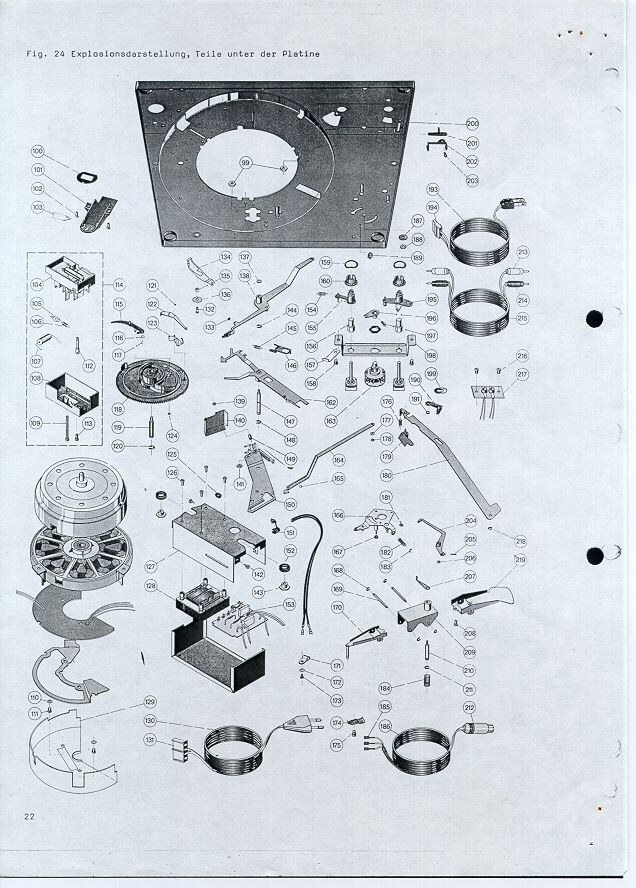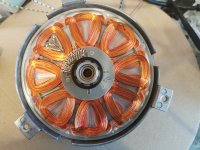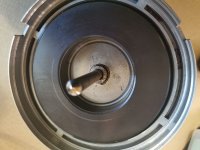it may work but it can also fry the electronics or the motor windings themselves...
Given that the 'running' current is pretty low, about 100mA, it's only the start current that's of any real concern. Although old, and Germanium, these transistors are specc'd at 2A collector current, the startup current being around 250mA should cause no problem, even if it takes a few more seconds to come up to speed.
I have recently acquired a 701 and have some concerns with the EDS1000. I have an internal rub over a small arc when rotating, coming from inside the motor assembly, audible from a meter back, and I have out of balance on the motor rotor. I have found that the rub can be removed by adjusting the height adjuster screw in (up) by about 20 degrees - but I haven't tried to run the motor in this configuration yet. On the out of balance I found I needed 14g of blue tack to rebalance (onto the edge of the subplatter). I am tempted to open the motor up to investigate this but would really appreciate some opinions from the knowledgable folks here first.
Its probable that the thrust bearing has worn a little, allowing the rotating part of the motor to come into contact with the coils. You can see if this is the case by removing the 2 screws holding the adjuster in place. The ideal position is to have the assembly as close together as possible without touching; if you can achieve clearance by adjusting the inner screw by 20 degrees, I would suggest between 30 and 45 degrees, then forget about it.
Has the turntable encountered a mechanical shock? - I suspect that it had, the rear corner of the outer frame has a tell tale dent. It may have jumped off a shelf.
Thanks ralphfcooke, I will have a look at the bearing.
But what about the out-of-balance, this is the mystery for me. A friend has one and that seems to be perfectly balanced. Not many things could cause this, bent shaft - but the platter seems to sit level relative to the plinth so unlikely. Could, possibly, the magnets move, that are fixed (somehow) to the inside of the rotor? How are they retained?
Should I try to ignore the balance, or risk opening it up (haven't seen any advice anywhere as how to do this)?
I think one approach is to look at the wow/flutter figures from my RPM App and see how that compares with the other motor, and go from there..
Thanks ralphfcooke, I will have a look at the bearing.
But what about the out-of-balance, this is the mystery for me. A friend has one and that seems to be perfectly balanced. Not many things could cause this, bent shaft - but the platter seems to sit level relative to the plinth so unlikely. Could, possibly, the magnets move, that are fixed (somehow) to the inside of the rotor? How are they retained?
Should I try to ignore the balance, or risk opening it up (haven't seen any advice anywhere as how to do this)?
I think one approach is to look at the wow/flutter figures from my RPM App and see how that compares with the other motor, and go from there..
This "out of balance" issue....... please describe it in better detail.
Is the platter edge revolving up and down as it spins?
If so, either the platter has been warped due to being dropped, or the motor "sub platter" has been damaged.
If the motor shaft is bent from true vertical, that's another matter, and a new motor is required.
There should be absolutely no "wobble" of the shaft in its bearing.
Dual went to extreme levels to fit and polish their motor shafts resulting in a "micro smooth" finish.
Also, the bottom thrust pad and bearing must be perfect, and lubricated with light grease such as Super Lube.
Is the platter edge revolving up and down as it spins?
If so, either the platter has been warped due to being dropped, or the motor "sub platter" has been damaged.
If the motor shaft is bent from true vertical, that's another matter, and a new motor is required.
There should be absolutely no "wobble" of the shaft in its bearing.
Dual went to extreme levels to fit and polish their motor shafts resulting in a "micro smooth" finish.
Also, the bottom thrust pad and bearing must be perfect, and lubricated with light grease such as Super Lube.
Out-of-balance - with the motor in my hands, if tilt it 45 degrees the the horizontal plane the rotor turns so that the heavy position swings to the lowest point. There is no swash (as we used to call it on gas turbine rotors) evident when spinning with the platter installed. Stays level. There is something invisible causing this. (Unless it is actually within manufacturing tolerances - which would seem unlikely given the caliber of the engineering that went into it.
On the thrust plate, what was the original form, flat? (Don't know what Super Lube is - sounds good though!)
On the thrust plate, what was the original form, flat? (Don't know what Super Lube is - sounds good though!)
If you remove the bottom plate with the thrust bearing, you will see a circlip holding the shaft in place. If you remove that the shaft and rotating part of the motor will separate from the rest. You can then inspect the internals.
It's that easy? Looked to me as thought there is a plate underneath the coils that is pressed into the rotor drum (which carries the magnets above the coils). So I would have to prise the plate off of the drum. Also, there is the drive gear, just above the bearing, with a thread locked locking screw on it (that I cannot budge - will need to somehow apply some heat to it). Or am I wrong?
I've two motors, one with just the shaft, and one with a gear (that's from my 721).
It's still a matter of removing the circlip, but also the gear 🙁. You may have to take the screw out quite a way, there's a flat on the shaft
And just as an aside, if the thrust bearing is too low, instead of the magnet touching the coils, the centre bush touches the inner casing, so no risk of damage to the coils. 🙂
It's still a matter of removing the circlip, but also the gear 🙁. You may have to take the screw out quite a way, there's a flat on the shaft
And just as an aside, if the thrust bearing is too low, instead of the magnet touching the coils, the centre bush touches the inner casing, so no risk of damage to the coils. 🙂
Last edited:
Great guys, that is really helpful! I think I see some balance weights in you shot of the motor there, ralphfcooke, or? In the slot on the right side. I will have a look at mine tonight.. (love the Best quote by the way!)
Last edited:
Dear All,
I don't recall seeing any balance weights in the rotor there is only a big magnet in it.
There are lead balance weights in the CS701 platter.
After long research on the nature of the bearing I concluded that it is a sintered bronze bearing with graphite lubrication.
This type of bearing is still manufactured in Germany this way for slow moving parts requiring no maintenance.
It does require a very polished axel surface that could have been worn or blemished by now and would need repolishing again.
The rotor comes of quite easily with a good push or pull as the metal plate needs to be separated from the magnet.
Hope this helps!
I don't recall seeing any balance weights in the rotor there is only a big magnet in it.
There are lead balance weights in the CS701 platter.
After long research on the nature of the bearing I concluded that it is a sintered bronze bearing with graphite lubrication.
This type of bearing is still manufactured in Germany this way for slow moving parts requiring no maintenance.
It does require a very polished axel surface that could have been worn or blemished by now and would need repolishing again.
The rotor comes of quite easily with a good push or pull as the metal plate needs to be separated from the magnet.
Hope this helps!
I lifted the bearing cover, the black lube was almost crusty, the thrust plate has a kind of teflon surface with a small dimple in the centre. Removed the drive gear after heating the grub screw with a jet lighter. The circlip was a tough job. Then came a thin washer that retained a tight washer that seems to be an oil dam for the journal bearing. The rotor did not lift away though, held in by the plate that is under the coils (that I mentioned above). It seems that is held in place by the magnetic pull from the ring magnet. I have stopped here for tonight. The grip of the magnet is very strong. If I slip separating these parts the the magnet could pull the ring back onto the coil assembly in an uncontrolled way. Looks like I need three clips to secure the plate to the main body, access for those through the three notches. Need to figure out a method. How did you manage this ralphfcooke? (thats me for tonight though)
Ah, now I see the post from Veeren (whats going on here), answering some things, thanks for that! So the coil assembly will take the load of separating the magnet and the plate, good to know.
Looks like balance weights to me, pushed into the slot, outside of the magnet, at about 2 o'clock and three o'clock.
Looks like balance weights to me, pushed into the slot, outside of the magnet, at about 2 o'clock and three o'clock.
I suspect that it's not the magnet stopping the rotor from detaching, but a very small amount of interference where the circlip groove is machined. The first time I took mine apart I used a small piece of 2000 grit wet-n-dry to polish around the groove.
I lifted the bearing cover, the black lube was almost crusty, the thrust plate has a kind of teflon surface with a small dimple in the centre.
Make sure you re-install all those parts in the same way after cleaning and re-oiling the bearing/shaft. (30Wt motor oil is good)
Except, flip the teflon disk over to it's fresh side against the shaft.
Adding a blob of Super Lube to the shaft's bottom point.
Thank you all for contributing to this thread!
What I have seen so far is that the teflon or nylon thrust plate is secured in place by dents in the metal thrust bearing housing.
I also advice against removing the metal wire that is running against the spindle.
It removes any static from the platter.
The earliest EDS1000 motors did not have those and customers would complain about static ticks during playback.
The bearing is not porous so any oil will eventually run down unless viscostatic.
Good point Ralphfcooke, never experienced that though.
Because of the magnet in the rotor acting like a brake on the unpowered coils is is hard
to judge the free running of the rotor bearing assembly.
It is however possible to check bearing play by putting 2 thumbs on the edge of the rotor and push gently to see if it rocks.
In that case some oil may be beneficial.
What I have seen so far is that the teflon or nylon thrust plate is secured in place by dents in the metal thrust bearing housing.
I also advice against removing the metal wire that is running against the spindle.
It removes any static from the platter.
The earliest EDS1000 motors did not have those and customers would complain about static ticks during playback.
The bearing is not porous so any oil will eventually run down unless viscostatic.
Good point Ralphfcooke, never experienced that though.
Because of the magnet in the rotor acting like a brake on the unpowered coils is is hard
to judge the free running of the rotor bearing assembly.
It is however possible to check bearing play by putting 2 thumbs on the edge of the rotor and push gently to see if it rocks.
In that case some oil may be beneficial.
- Home
- Source & Line
- Analogue Source
- Dual EDS1000 and EDS1000-2 direct drive motor


